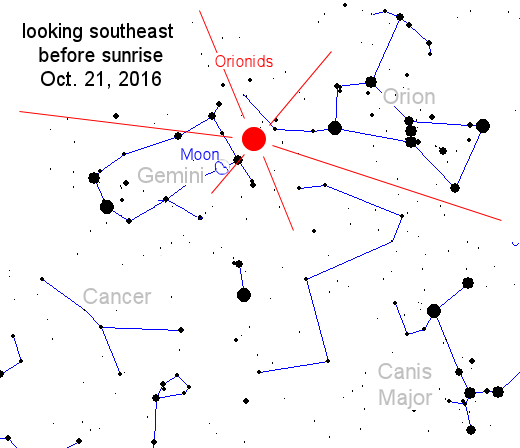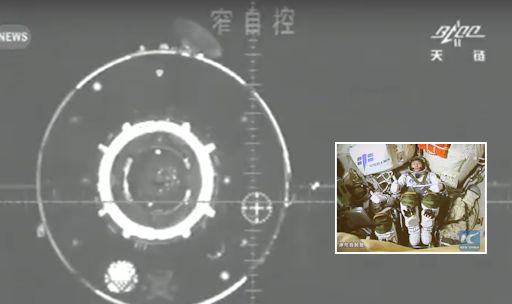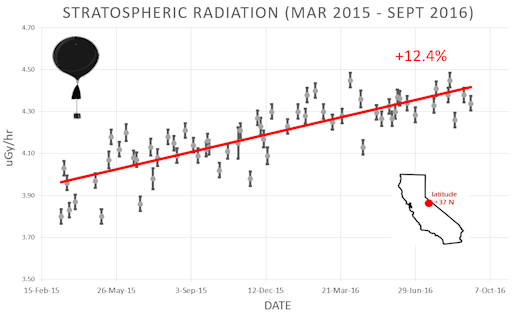Directly under the Arctic Circle! Marianne's Arctic Xpress in Tromsø offers fjord, whale and wildlife tours by day, aurora tours by night. Book Now and get a 10% discount on combo day and night adventures. | | | WHAT HAPPENED YESTERDAY ON MARS?: Landing on Mars is not easy. In the history of the Space Age, almost half of all probes sent to the surface of the Red Planet did not survive the trip. Yesterday, the European Space Agency tried again. At approximately 15:00 GMT on Oct 19th, ESA's Schiaparelli lander entered the martian atmosphere and ... promptly lost contact with Earth. Mission controllers aren't sure what happened. If Schiaparelli reached the surface safely, its batteries should be able to support operations for three to ten days, offering multiple opportunities to re-establish a communication link. Stay tuned for updates. METEORS FROM HALLEY'S COMET: Earth has entered a stream of debris from Halley's comet, source of the annual Orionid meteor shower. Forecasters expect the shower to peak during the night of Oct. 20-21 with rates of 10 to 20 meteors per hour. The best time to look is during the hours before local sunrise on Oct. 21st when Orion is high in the sky. [sky map] 
Unfortunately, as the sky map above shows, the bright gibbous Moon will be high in the sky, too. Only the brightest Orionids will be visible through the glare. Now for the good news: This meteor shower produces a fair number of fireballs--that is, meteors brighter than the planet Venus, easily seen in bright moonlight. Just last night, NASA's network of all-sky meteor cameras recorded 11 Orionid fireballs over the USA. Amateur astronomer Thomas Ashcraft caught this beauty streaking over his observatory in rural New Mexico: "As you can see in the video, brilliant occasional Orionid fireballs are still quite visible even in bright moonlight," says Ashcraft. Readers, when you play the video, don't forget to turn up the volume. You can hear the signals of distant radio transmitters reflecting from the ionized trail of the fireball. "The full radio reflection lasted nearly two minutes," he says. Got clouds? Listen to the shower live on Space Weather Radio. Realtime Meteor Photo Gallery CHINA'S NEW SPACE STATION IS NOW OCCUPIED: On Oct 18th, Chinese astronauts onboard the Shenzhou 11 spacecraft docked with China's new space station, the Tiangong 2. Moments before the link-up, cameras on the Shenzhou 11 photographed the station's docking port as the two craft flew in tandem 250 miles above Earth: 
This means there are now two occupied space stations orbiting Earth. The other one, of course, is the International Space Station (ISS). Compared to the ISS, the Tiangong 2 is small. Indeed, it nearly doubled in size when the Shenzhou 11 joined it. Linked together, the merged spacecraft will orbit Earth for the next month providing a home in space about the size of a double decker bus. If all goes as planned, astronauts Jing Haipeng and Chen Dong will more than double the record for the longest-duration Chinese crewed mission, extending the mark from 15 days to 33 days. They will spend their time conducting science experiments and rehearsing procedures for future missions: Within a few years, China plans to start launching modules for a much larger Mir-class space station slated for completion in the 2020s. Realtime Space Weather Photo Gallery Realtime Aurora Photo Gallery
Realtime Airglow Photo Gallery
Realtime Sprite Photo Gallery
| | Cosmic Rays in the Atmosphere |
Updated: Sept. 29 2016 // Next Flight: Oct. 1, 2016
Sept. 20, 2016: Readers, thank you for your patience while we continue to develop this new section of Spaceweather.com. We've been working to streamline our data reduction, allowing us to post results from balloon flights much more rapidly, and we have developed a new data product, shown here: 
This plot displays radiation measurements not only in the stratosphere, but also at aviation altitudes. Dose rates are expessed as multiples of sea level. For instance, we see that boarding a plane that flies at 25,000 feet exposes passengers to dose rates ~10x higher than sea level. At 40,000 feet, the multiplier is closer to 50x. These measurements are made by our usual cosmic ray payload as it passes through aviation altitudes en route to the stratosphere over California. What is this all about? Approximately once a week, Spaceweather.com and the students of Earth to Sky Calculus fly space weather balloons to the stratosphere over California. These balloons are equipped with radiation sensors that detect cosmic rays, a surprisingly "down to Earth" form of space weather. Cosmic rays can seed clouds, trigger lightning, and penetrate commercial airplanes. Furthermore, there are studies ( #1, #2, #3, #4) linking cosmic rays with cardiac arrhythmias and sudden cardiac death in the general population. Our latest measurements show that cosmic rays are intensifying, with an increase of more than 12% since 2015: 
Why are cosmic rays intensifying? The main reason is the sun. Solar storm clouds such as coronal mass ejections (CMEs) sweep aside cosmic rays when they pass by Earth. During Solar Maximum, CMEs are abundant and cosmic rays are held at bay. Now, however, the solar cycle is swinging toward Solar Minimum, allowing cosmic rays to return. Another reason could be the weakening of Earth's magnetic field, which helps protect us from deep-space radiation. The radiation sensors onboard our helium balloons detect X-rays and gamma-rays in the energy range 10 keV to 20 MeV. These energies span the range of medical X-ray machines and airport security scanners. The data points in the graph above correspond to the peak of the Reneger-Pfotzer maximum, which lies about 67,000 feet above central California. When cosmic rays crash into Earth's atmosphere, they produce a spray of secondary particles that is most intense at the entrance to the stratosphere. Physicists Eric Reneger and Georg Pfotzer discovered the maximum using balloons in the 1930s and it is what we are measuring today. Every night, a network of NASA all-sky cameras scans the skies above the United States for meteoritic fireballs. Automated software maintained by NASA's Meteoroid Environment Office calculates their orbits, velocity, penetration depth in Earth's atmosphere and many other characteristics. Daily results are presented here on Spaceweather.com. On Oct. 20, 2016, the network reported 46 fireballs.
(30 sporadics, 11 Orionids, 3 Leonis Minorids, 1 epsilon Geminid, 1 Southern Taurid)  In this diagram of the inner solar system, all of the fireball orbits intersect at a single point--Earth. The orbits are color-coded by velocity, from slow (red) to fast (blue). [Larger image] [movies] Potentially Hazardous Asteroids ( PHAs) are space rocks larger than approximately 100m that can come closer to Earth than 0.05 AU. None of the known PHAs is on a collision course with our planet, although astronomers are finding new ones all the time. On October 20, 2016 there were 1736 potentially hazardous asteroids. Notes: LD means "Lunar Distance." 1 LD = 384,401 km, the distance between Earth and the Moon. 1 LD also equals 0.00256 AU. MAG is the visual magnitude of the asteroid on the date of closest approach. | | The official U.S. government space weather bureau | | | The first place to look for information about sundogs, pillars, rainbows and related phenomena. | | | Researchers call it a "Hubble for the sun." SDO is the most advanced solar observatory ever. | | | 3D views of the sun from NASA's Solar and Terrestrial Relations Observatory | | | Realtime and archival images of the Sun from SOHO. | | | from the NOAA Space Environment Center | | | a proud supporter of science education and Spaceweather.com | | | the underlying science of space weather |  | Find homes for sale in Ocala, Orlando and Tampa with the #1 real estate company in Central Florida Local Realty Service |  | Visit Need An Eitzah for all your questions and forum discussions on Jewish life. | | | These links help Spaceweather.com stay online. Thank you to our supporters! | | 
